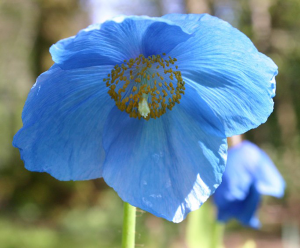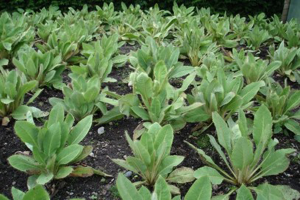| Fertile Blue Group ∨ | Infertile Blue Group ∨ | George Sherriff Group ∨ | Others ∨ |
There are now over 100 different cultivars and hybrids of Meconopsis ranging in colour from blue to purple to white, pink and red. Some are small while others can be more than a metre tall. The majority of them are sterile, the result of hybridisation between parents with different chromosome numbers. These can only be propagated by division. A few are fertile with an even number of chromosomes. These can be propagated both from seed and by division. Selected forms of fertile hybrids should only be propagated by division to maintain their special characteristics. The many garden hybrids available today are the result of random cross fertilisation by insects while some are from deliberate crosses.
Meconopsis cultivars
Meconopsis
species occur in geographically widely separated wild habitats where
they would not normally come into contact with each other. Few natural
hybrids exist. Different species introduced into gardens in the late
1800s and early in the twentieth century and grown in close proximity to
one another provided opportunities for hybridisation. The species
originally involved are thought to be Meconopsis grandis subspecies grandis, introduced into cultivation around 1896, Meconopsis baileyi (once erroneously identified as Meconopsis betonicifolia,
a different species), discovered by Col. F.M. Bailey in 1913 and
subsequently introduced into cultivation in 1924 by Frank Kingdon Ward,
and M. simplicifolia, introduced in the late nineteenth
century. This last species was once more common in gardens than it is
now. An important later introduction was Meconopsis gakyidiana (once named Meconopsis grandis subspecies orientalis) from Bhutan, by Ludlow and Sherriff in 1934.

Meconopsis ‘Mrs Jebb’ in the Davidia Border at Holehird Gardens, Cumbria where there is a National Collection of Meconopsis.

The Meconopsis enclosure in the former National Collection
in Dunblane at the home of the late Dr Evelyn Stevens.
Why are most of the cultivars sterile?
Meconopsis species are cross pollinators. They need other plants of the same species nearby to set large quantities of good seed. (The same is true for each of the fertile hybrids.) Species grown in isolation in gardens could not receive pollen from other similar plants. These isolated plants either produced no seed or very little seed. Gradually later generations of such plants became sterile.
The Genus Meconopsis has always been popular with gardeners and so any vigorous, robust hybrid would have been passed around. This eventually led to problems of identification and naming of the various hybrids grown in gardens. The Meconopsis Group was founded in 1998 initially to clarify the identities and nomenclature of the many forms of the big blue perennial poppies found in cultivation. In order to do this the plants were divided into horticultural groups based on defined similarities. The Groups used were:
The George Sherriff Group, consisting of plants thought to be derived from introductions by Ludlow and Sherriff (GSG). They are usually sterile, but if any seeds are obtained, any plants raised will not be the same as the named clone, so they should not be labelled with the name of the parent.

Meconopsis ‘Jimmy Bayne’ GSG

Meconopsis ‘Dalemain’ GSG
The Infertile Blue Group, with blue flowers, which are all sterile hybrids producing few or no seeds (IBG).
Occasionally some seeds that have been produced are included in The Meconopsis Group seed exchange. They are provided for reseach purposes only. Any plants that are raised should not be labelled with the name of the parent, as they will not be the same as the named clone. These seeds are listed with an MSG number. Click here for a list of these numbers with the names of the parent clones.

Meconopsis ‘Slieve Donard’ (IBG) at The Royal Botanic Garden Edinburgh.
The Fertile Blue Group, with blue flowers that produce seeds. (FBG)

Meconopsis ‘Lingholm’ FBG

Meconopsis ‘Lingholm’ (FBG) bed at
Holehird garden. © Pat Murphy.
As different cultivars were given to The Meconopsis Group and identified they were given Meconopsis Group Numbers (MG Nos). After assessment and approval by the Group named hybrids have been registered by The Meconopsis Group.
National Collections of Meconopsis and wonderful garden displays can be seen at Gardens. Nurseries who are able to provide an excellent supply of Meconopsis can be found at Nurseries.

Meconopsis ‘Ascreavie’ at The
National collection of Meconopsis
at The Scottish Plant Hunters
garden, The Explorers Garden,
Pitlochry. © Julia Corden.

Meconopsis George Sherriff Group
growing at The National collection
of Meconopsis at Branklyn Garden
Perth. © Jim Jermyn.